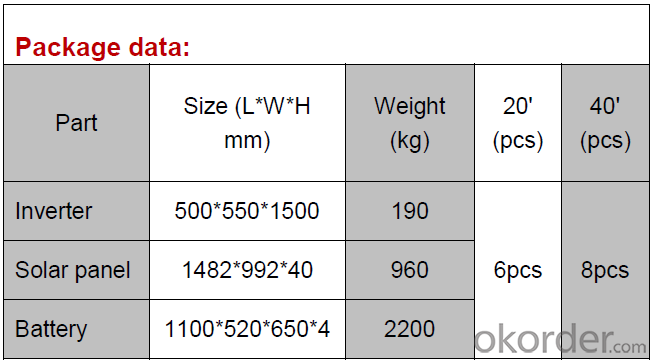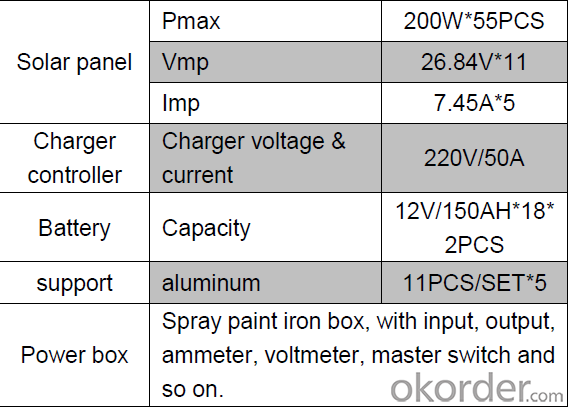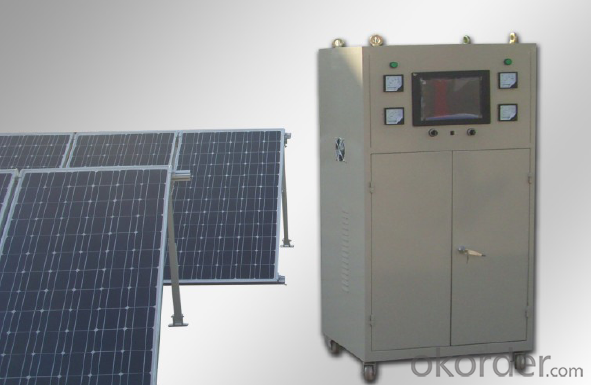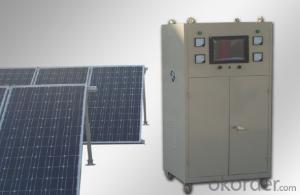Solar Home System CNBM-K8 5KW from CNBM
- Loading Port:
- China main port
- Payment Terms:
- TT OR LC
- Min Order Qty:
- 1 watt
- Supply Capability:
- 100000000 watt/month
OKorder Service Pledge
OKorder Financial Service
You Might Also Like
Item specifice
Description:
CNBM Solar is a world-leading and Vertical integrated manufacturer ofhigh-performance with Silicon,
Wafer, Cells, Modules, which convertsunlight into electricity for residential, commercial, and utility-scale
power generation.
The capacity of CNBMSolar is reach to 1GW, andmake sure each year our shipment capacity is more
Than 700-800MWs, at the same time, wehave set up the largest solar power station with our partner
in Ukraine.
CNBM is a Quality + Service orientedcompany with“Excellence at Each Step” approach, composed of
the finest components from TUV andIEC-certified partners around the world, CNBM modules consistently
undergo a variety of trials at thecompany’s Test & Development Centre, ensuring peak performance
capabilities. The company iscommitted to develop and provide the world with clean and renewable energy
to ease the energy shortages as wellas human kind’s impact on the environment.
Data:




FAQ:How long can we receive the product after purchase?
In the purchase of product within three working days, We will arrange the factory delivery as soon as possible. The pecific time of receiving is related to the state and position of customers.Commonly 7 to 10 working days can be served.
- Q:How do solar energy systems contribute to reducing the risk of electrical fires compared to traditional power generation methods?
- Solar energy systems contribute to reducing the risk of electrical fires compared to traditional power generation methods because they do not rely on flammable fossil fuels or complex mechanical systems. Solar panels convert sunlight directly into electricity, eliminating the need for fuel combustion or extensive electrical wiring. This significantly reduces the risk of accidental fires caused by fuel leaks, short circuits, or electrical malfunctions, making solar energy systems a safer and more reliable alternative.
- Q:Can solar energy systems be used for air purification or water treatment?
- Yes, solar energy systems can be used for both air purification and water treatment. Solar-powered air purifiers utilize photovoltaic panels to generate electricity to power air filtration systems, removing pollutants and improving air quality. Additionally, solar-powered water treatment systems use solar energy to power pumps and filtration processes, making it possible to purify water from various sources, such as rivers or wells, for safe drinking or irrigation purposes.
- Q:Can solar energy systems be used in conjunction with backup generators?
- Yes, solar energy systems can be used in conjunction with backup generators. This combination allows for a reliable and uninterrupted power supply, as solar panels can generate electricity during the day while excess energy can be stored in batteries or fed back into the grid. Backup generators can then be used as a secondary power source during periods of low solar generation or in case of emergencies.
- Q:Can solar energy systems be used in areas with limited access to solar energy warranties and guarantees?
- Yes, solar energy systems can still be used in areas with limited access to solar energy warranties and guarantees. While warranties and guarantees provide added assurance and protection, the feasibility of using solar energy systems in such areas would depend on the available sunlight and other factors like the system's efficiency, maintenance, and durability. It would be important to assess the specific conditions and potential challenges of the area to determine the viability of installing solar energy systems and explore alternative options to mitigate risks in the absence of comprehensive warranties and guarantees.
- Q:How much energy can a solar energy system produce?
- The amount of energy a solar energy system can produce depends on various factors such as the size and efficiency of the system, location, weather conditions, and available sunlight. On average, a typical solar energy system can produce anywhere from 1 to 10 kilowatt-hours (kWh) of electricity per day for every installed kilowatt (kW) of solar panels. For example, a 5 kW solar energy system can generate around 5 to 50 kWh of electricity per day, which can be enough to power the average household's energy needs. However, it is important to note that this energy production can vary throughout the year due to seasonal changes in sunlight availability and weather conditions. Moreover, advancements in solar technology and increased efficiency of solar panels have led to significant improvements in energy production. High-performance solar panels and optimized system designs can generate even more electricity, maximizing the energy output of a solar energy system. Additionally, excess energy produced by a solar energy system can be stored in batteries for later use or fed back into the grid, depending on the specific setup and local regulations. This allows for further utilization and optimization of solar energy production. Ultimately, the potential energy production of a solar energy system is a dynamic and customizable aspect that can be tailored to individual energy needs and goals. Consulting with a solar energy professional can provide more accurate estimates and help design a system that best meets specific requirements.
- Q:Can solar energy systems be used in areas with high levels of dust or dirt?
- Yes, solar energy systems can be used in areas with high levels of dust or dirt. However, the efficiency of the system may be reduced due to the accumulation of dust or dirt on the solar panels. Regular cleaning and maintenance can help optimize the system's performance in such environments.
- Q:Can solar panels be used to power agricultural irrigation systems?
- Yes, solar panels can be used to power agricultural irrigation systems. Solar energy can be harnessed and converted into electricity to power water pumps and other irrigation equipment, providing a sustainable and reliable source of power for agriculture. This helps reduce reliance on traditional energy sources and contributes to more environmentally friendly farming practices.
- Q:Can solar energy systems be used for powering off-grid research stations in Antarctica?
- Yes, solar energy systems can be used for powering off-grid research stations in Antarctica. Solar panels can be installed to capture sunlight and convert it into electricity, which can then be stored in batteries for use during periods of low sunlight. This renewable energy source is a viable and sustainable option for powering remote research stations in Antarctica, reducing reliance on fossil fuels and minimizing environmental impact.
- Q:Are there any limitations to the lifespan of solar energy systems?
- Yes, there are limitations to the lifespan of solar energy systems. The most significant limitation is the degradation of the solar panels over time. Solar panels are made up of photovoltaic (PV) cells that convert sunlight into electricity. These cells degrade gradually, losing efficiency as they age. On average, solar panels experience a degradation rate of around 0.5-1% per year, which means that after 25-30 years, the panels might only produce around 75-80% of their original power output. Another limitation is the lifespan of other components in the solar energy system, such as inverters, batteries (if present), and wiring. Inverters, which convert the DC electricity generated by the solar panels into AC electricity for use in homes or businesses, typically have a lifespan of 10-15 years. Batteries, if used for energy storage, also have a limited lifespan, usually around 5-10 years. Wiring can deteriorate over time due to exposure to the elements, requiring maintenance or replacement. Furthermore, environmental factors can impact the lifespan of solar energy systems. Extreme weather conditions like hailstorms, hurricanes, or heavy snow can damage solar panels, reducing their efficiency or even rendering them inoperable. Additionally, excessive heat can accelerate the degradation of solar panels, shortening their lifespan. However, it is important to note that while solar energy systems have limitations, proper maintenance and regular inspections can help maximize their lifespan and performance. Many solar panels come with warranties that guarantee their performance for a certain number of years, often ranging from 20 to 25 years. Moreover, technological advancements and improvements in manufacturing processes are constantly being made, which may lead to longer-lasting and more efficient solar energy systems in the future.
- Q:Can solar energy systems be used in areas with high levels of dust?
- Yes, solar energy systems can be used in areas with high levels of dust. While dust can potentially reduce the efficiency of solar panels, it is still possible to generate electricity from sunlight. Regular cleaning and maintenance of the solar panels can help mitigate the impact of dust on their performance. Additionally, advancements in solar panel technology, such as anti-soiling coatings and self-cleaning mechanisms, have made it easier to maintain their efficiency in dusty environments. However, it is important to note that the effectiveness of solar energy systems in dusty areas may vary depending on the severity and type of dust present.
1. Manufacturer Overview |
|
|---|---|
| Location | |
| Year Established | |
| Annual Output Value | |
| Main Markets | |
| Company Certifications | |
2. Manufacturer Certificates |
|
|---|---|
| a) Certification Name | |
| Range | |
| Reference | |
| Validity Period | |
3. Manufacturer Capability |
|
|---|---|
| a)Trade Capacity | |
| Nearest Port | |
| Export Percentage | |
| No.of Employees in Trade Department | |
| Language Spoken: | |
| b)Factory Information | |
| Factory Size: | |
| No. of Production Lines | |
| Contract Manufacturing | |
| Product Price Range | |
Send your message to us
Solar Home System CNBM-K8 5KW from CNBM
- Loading Port:
- China main port
- Payment Terms:
- TT OR LC
- Min Order Qty:
- 1 watt
- Supply Capability:
- 100000000 watt/month
OKorder Service Pledge
OKorder Financial Service
Similar products
New products
Hot products
Hot Searches
Related keywords





























